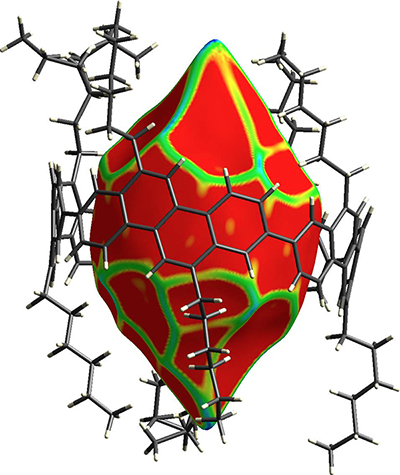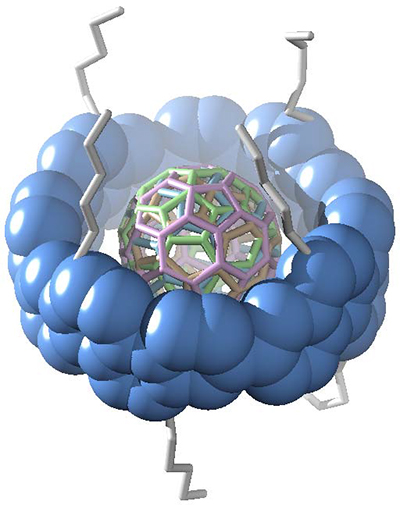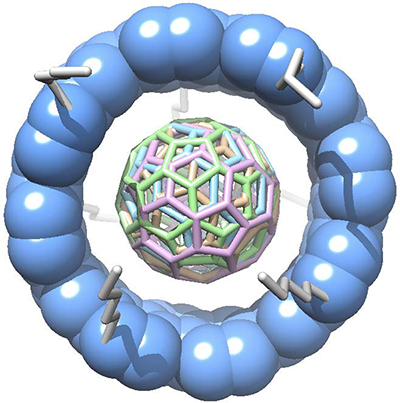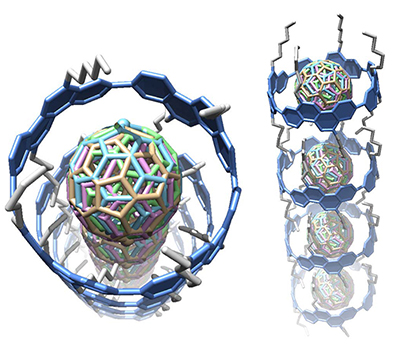Release Date 2014-05-27
Slippery Smooth Surface for Free-Rotation of Inner Fullerene in Finite Carbon Nanotube Molecules
Key points
-
Discovery of nanosize bearings (molecular bearings) that freely rotate like a spinning top inside a tubular molecule even in the solid state</>
- Clarification that finite carbon nanotube molecules are tubular with a smooth inner surface
A research group led by Professor Hiroyuki Isobe of Tohoku University, who is also in charge of the Isobe Degenerate π-Integration Project of Exploratory Research for Advanced Technology (ERATO) supported by JST, has clarified the atomic-level structure of a molecular peapod, namely, a carbonaceous combination of carbon nanotube and fullerene. Since its discovery of the peapod-like structures in 1998, the unique supramolecular combination has attracted much interest. The precise molecular structure of the carbonaceous peapod, however, remained unclarified at the atomic level.
Researchers involved in this study have very recently developed a molecular peapod with a simple and discrete tubular structure and found that a fullerene molecule encapsulated inside the short and finite tube is so firmly captured that it cannot escape from the tube and that it rotates inside the tube in the solution state. In this study, they now clarified that (1) the fullerene molecule in the molecular peapod freely rotates even in the solid state, in which ordinary molecules stop their motions and (2) there is an extremely smooth, inflection-free surface inside the finite carbon nanotube molecule. The analysis was made possible with the high-flux X-ray beams of SPring-8 and Photon Factory of KEK. Their observations suggest that the smooth inner surface of carbon nanotubes is an essential structural feature for the encapsulated fullerene molecule to rotate. The findings will provide a first-step basis for the design of nanosize machines (molecular machines) with smooth dynamic motions in the solid state.
This study was carried out as part of the Isobe Degenerate π-Integration Project of ERATO as a JST Strategic Basic Research Program and was also supported by a Grant-in-Aid for Scientific Research from the Ministry of Education, Culture, Sports, Science and Technology and the Japan Society for the Promotion of Science. The results of this study were published in the American Scientific Journal Proceedings of the National Academy of Science of the United States of America (PNAS).

Fig.1
Crystal structure of molecular peapod with four disordered fullerene molecules
Finite carbon nanotube molecules are shown in stick models, and the contacting surface of inner C60 is shown with curvedness color mapping. The surface of the region surrounded by the finite carbon nanotube molecules (center region) is uniformly shaded in red to show the smoothness without inflection points* (indicated in yellow-green).

Fig.2
Crystal structure of molecular peapod with four disordered fullerene molecules
The fullerene molecules have four orientations inside the tube. The blue ball models show the wall of a finite carbon nanotube molecule, and the fullerene molecules entrapped at the center is color-coded according to the orientations.

Fig.3
Crystal structure of molecular peapod with four disordered fullerene molecules
The top view of Fig. 2. The solid was rapidly cooled down to -173 °C, and the fullerene molecules were frozen at various orientations. The blue ball models show the wall of a finite carbon nanotube molecule, and the fullerene molecules entrapped at the center is color-coded according to the orientations.

Fig.4
Packing structures of molecular peapod
The tubular molecules are aligned along the cylindrical axis. Two carbon atoms (indicated by ball models) on the C60 molecules at the various orientations were located at the identical spatial positions, which may act as an axis for single-axis rotation.
